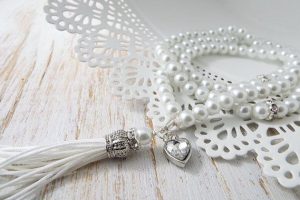 The method of correcting people adopted by Rasulullah (sallallahu ‘alaihi wasallam)
The method of correcting people adopted by Rasulullah (sallallahu ‘alaihi wasallam)
عن أنس بن مالك عن رسول الله صلى الله عليه وسلم أنه كان عنده رجل به أثر صفرة قال وكان رسول الله صلى الله عليه وآله وسلم لا يكاد يواجه أحدا بشيء يكرهه فلما قام قال للقوم لو قلتم له يدع هذه الصفرة (الشمائل المحمدية للترمذي رقم: 329)
Translation
Hazrat Anas bin Maalik (radhiyallahu ‘anhu) reports that on one occasion, a person wearing clothing which had a trace of yellow dye (from saffron or safflower) on it was seated in the mubaarak gathering of Rasulullah (sallallahu ‘alaihi wasallam). It was the (noble) habit of Rasulullah (sallallahu ‘alaihi wasallam) that he would not directly address a person (and correct him) in regard to something he disapproved of. (Therefore, Rasulullah (sallallahu ‘alaihi wasallam) remained silent.) Thereafter, when the person stood and left the gathering, Rasulullah (sallallahu ‘alaihi wasallam) addressed those who were present in the gathering saying, “It would have been better if you had told him to leave using this yellow dye (i.e. you should correct him and advise him to stop using this dye as yellow dye is only permissible for women).”
Commentary:
It was the noble habit of Rasulullah (sallallahu ‘alaihi wasallam) that he would not directly address a person and correct him when he found him doing something which was of an undesirable nature and which he disliked.
The reason for Rasulullah (sallallahu ‘alaihi wasallam) not directly addressing a person and correcting him was due to the possibility that the person could reject or object to what Rasulullah (sallallahu ‘alaihi wasallam) mentioned to him. In this case, the person’s reaction would be tantamount to kufr and would cause him to leave the fold of Islam. Hence, Rasulullah (sallallahu ‘alaihi wasallam) not directly addressing the person was on account of his compassion when dealing with the ummah.
However, in regard to situations where Rasulullah (sallallahu ‘alaihi wasallam) felt that directly addressing a person and correcting him would not lead to this, or Rasulullah (sallallahu ‘alaihi wasallam) knew that the person would be pleased with immediate correction, Rasulullah (sallallahu ‘alaihi wasallam) immediately corrected the person. Hence, there are many examples where Rasulullah (sallallahu ‘alaihi wasallam) directly addressed certain Sahaabah and corrected them.
Hazrat Sheikh Moulana Muhammed Zakariyya (rahimahullah) mentioned that whenever Rasulullah (sallallahu ‘alaihi wasallam) delayed in correcting someone – as in the Hadith under discussion – the issue which required correction was undesirable in Shari‘ah or it was such that its correction could be delayed in Shari‘ah. However, if the issue related to something which was haraam, then Rasulullah (sallallahu ‘alaihi wasallam) did not delay, but immediately corrected the person, as this related to the rights of Allah Ta‘ala.
Hazrat Aaishah (radhiyallahu ‘anha) reports, “Rasulullah (sallallahu ‘alaihi wasallam) never took revenge for himself, but if any command of Allah Ta‘ala was violated (i.e. a haraam deed was committed), then he surely disciplined or punished the evil doer.” (Saheeh Bukhaari #3560)
Similarly, it is reported from Hazrat Hasan (radhiyallahu ‘anhu) in a lengthy narration, “If any right of Allah Ta‘ala was violated, then Rasulullah (sallallahu ‘alaihi wasallam) would become angered and nothing could prevent his anger. Until he did not punish the perpetrator and defend the right of Allah Ta‘ala, his anger would not subside.” (Shamaail Tirmizi #215)
One example of Rasulullah (sallallahu ‘alaihi wasallam) directly addressing a Sahaabi and correcting him is where Rasulullah (sallallahu ‘alaihi wasallam) directly addressed Hazrat Abdullah bin Amr bin Aas (radhiyallahu ‘anhuma) and prohibited him from wearing clothing that was entirely dyed yellow with saffron or safflower when he saw him wearing it. Since wearing this is impermissible for men, Rasulullah (sallallahu ‘alaihi wasallam) immediately corrected him and said, “This is from the clothing of the kuffaar, hence do not wear it.” Hazrat Abdullah bin Amr bin Aas (radhiyallahu ‘anhuma) asked Rasulullah (sallallahu ‘alaihi wasallam) whether he could wash the clothing and remove the yellow dye. Rasulullah (sallallahu ‘alaihi wasallam) replied, “No, do not wash it, instead burn the clothing.” (Saheeh Muslim #2077)
Mulla Ali Qaari (rahimahullah) has explained that though washing the dye from the clothing was permissible, Rasulullah (sallallahu ‘alaihi wasallam) commanded him to burn it, as he wished to emphasize to him the severity of this sin.[1]
One noteworthy point is that in the Hadith of Hazrat Abdullah bin Amr (radhiyallahu ‘anhuma), Rasulullah (sallallahu ‘alaihi wasallam) commanded him to burn the clothing, as his entire clothing was dyed with yellow and this is haraam for men. However, in the Hadith under discussion, Rasulullah (sallallahu ‘alaihi wasallam) did not correct the Sahaabi, as his clothing merely had a trace of yellow dye on it, and this amount is undesirable.
Another example of this is the incident of Hazrat Abdur Rahmaan bin Auf (radhiyallahu ‘anhu). When Rasulullah (sallallahu ‘alaihi wasallam) met him after his nikaah, he found a trace of yellow khalooq (a type of yellow itr used by women) on his clothing. Rasulullah (sallallahu ‘alaihi wasallam) was unaware of his nikaah until that point, and only realised that he had married when he saw a trace of the yellow itr of his wife which had rubbed onto his clothing. Rasulullah (sallallahu ‘alaihi wasallam) asked him, “What is this yellow dye on your clothing?” He replied, “I have made nikaah, O Nabi of Allah,” implying that through interacting with my wife, this yellow colour had come on my clothes. Rasulullah (sallallahu ‘alaihi wasallam) did not take him to task for this small amount, but through this question, indicated to him that it was better for him to remove the trace of yellow.
When the person stood and left the gathering, Rasulullah (sallallahu ‘alaihi wasallam) addressed those who were present in the gathering saying, “It would have been better if you had told him to leave using this yellow dye.”
From this portion of the Hadith, we learn that mentioning the mistake or the undesirable act of a person which was carried out in public with the intention of rectifying the mistake is permissible and will not enter under the purview of gheebah.
From this Hadith, we also understand that all types of actions which are disliked in Shari‘ah do not require the same method of correction. In the case where the action is of a haraam nature, the correction will not be the same as in the case where the action is of an undesirable nature.
Similarly, we understand that though clothing falls under the category of Sunan-e-Zawaa’id, there are Ahkaam and injunctions that relate to it. Just as we are commanded to follow the sunnah of Rasulullah (sallallahu ‘alaihi wasallam) in Sunan-e-Hudaa (acts of worship), we are similarly commanded to follow Rasulullah (sallallahu ‘alaihi wasallam) in Sunan-e-Zawaa’id actions e.g. clothing, eating, drinking, sleeping, etc.
[1]جمع الوسائل 3/265
 Ihyaaud Deen An Effort to Revive Deen in Totality
Ihyaaud Deen An Effort to Revive Deen in Totality



